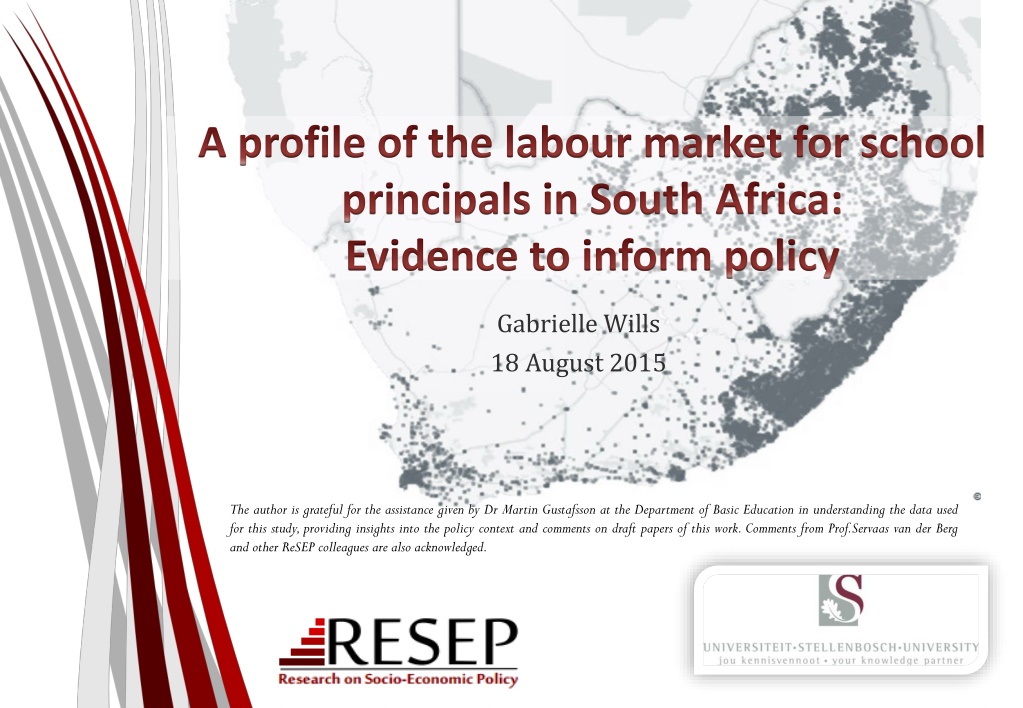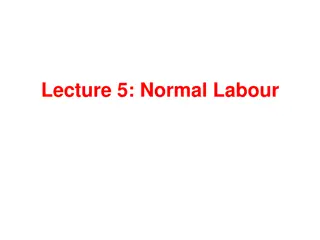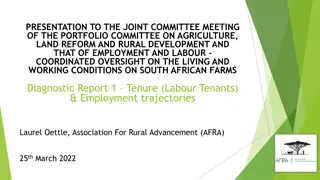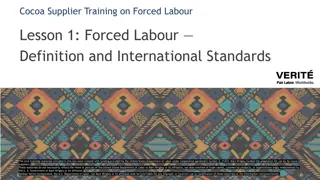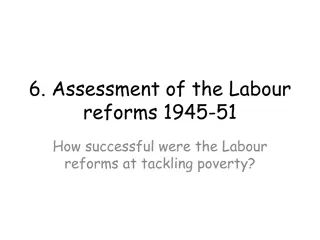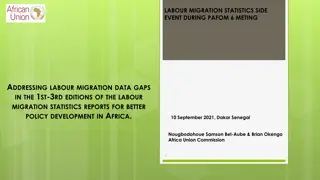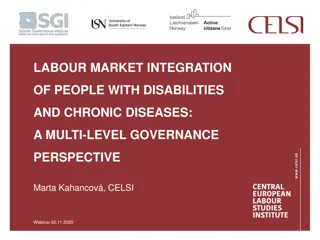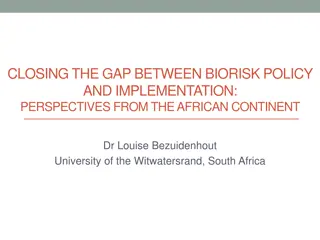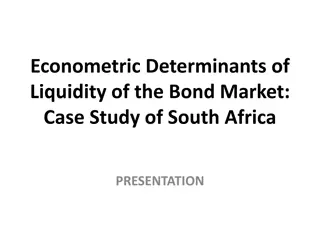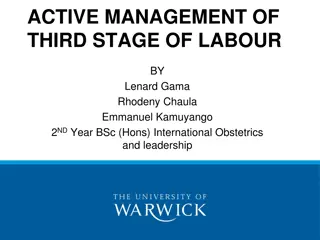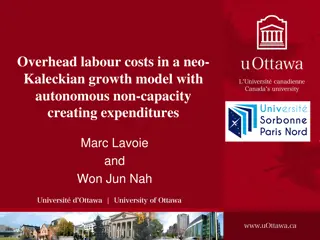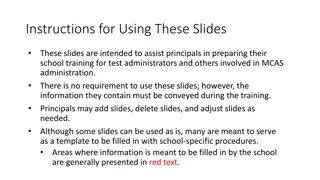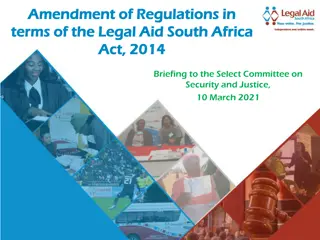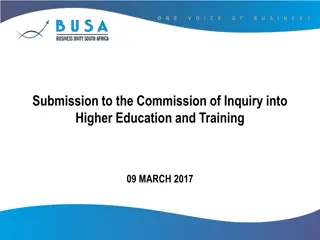Understanding the Labour Market for School Principals in South Africa
The labour market for school principals in South Africa is crucial for student learning and school effectiveness. Evidence shows that effective principals significantly impact student achievements. Policy changes have aimed to enhance school leadership quality and accountability, but questions remain on inducing behavioral change for improved learning outcomes.
Download Presentation

Please find below an Image/Link to download the presentation.
The content on the website is provided AS IS for your information and personal use only. It may not be sold, licensed, or shared on other websites without obtaining consent from the author. Download presentation by click this link. If you encounter any issues during the download, it is possible that the publisher has removed the file from their server.
E N D
Presentation Transcript
A profile of the labour market for school principals in South Africa: Evidence to inform policy Gabrielle Wills 18 August 2015 The author is grateful for the assistance given by Dr Martin Gustafsson at the Department of Basic Education in understanding the data used for this study, providing insights into the policy context and comments on draft papers of this work. Comments from Prof.Servaas van der Berg and other ReSEP colleagues are also acknowledged.
Introduction & background There is convincing evidence that school principals matter considerably for student learning across both education & economics literature: oLeithwood et al (2004) review of case studies of school leadership in the U.S. and Europe: school principals are only 2nd to teachers in terms of their importance for student learning & school effectiveness in general. Indeed, there are virtually no documented instances of troubled schools being turned around without intervention by a powerful leader. Many other factors may contribute to such turnarounds, but leadership is the catalyst (Leithwood et al., 2004: 7)
Introduction & background Growing evidence in the U.S. from value-added models using large-scale datasets that school principals matter a lot for student learning. Value- added models Identify the additional value that principals bring to learning after isolating out the contributions of individual teachers, the school & the ability & backgrounds of individual students. A highly effective principal can raise the achievement of the average student by 2-7 months of learning in a year (Branch, Hanushek & Rivkin 2012; see also Coelli & Green 2012; Grissom, Kalogrides & Loeb 2012; Chiang, Lipscomb & Gill 2012). o Only 2nd to the direct effects of individual teacher quality on learning but principals affect all students in a school. o The overall impact from increasing principal quality substantially exceeds the benefit from a comparable increase in teacher quality.
What about policy? Principals form part of a strategic sector that has not been duly explored in its potential for contributing to education progress. Weinstein, Munoz & Raczynski 2011:298 - In SA, there have been notable shifts in raising the value of school leadership & management as critical levels for learning gains. - Amendments to legislation, statements & action of the DBE & in national policy plans Education Amendment Act 2007 - Increased accountability for principals: requirement to plan for academic improvements and report against targets set. o But does this induce the kind of behavioural change that results in more learning? o Form vs. substance- Taylor 2014; Buffering -Elmore 2000 - Allows for temporary replacement of principals in underperforming schools.
Policy progress Standards for Principalship draft policy -Redefines the roles and responsibilities of school principals -More focus on instructional leadership than PAMS job description IQMS -Implementation challenges. CMs not evaluating principals in many circuits; too easy to get high ratings (DBE, 2012: 44**) -Are carrots & sticks effective to induce the right kind of behavioural change? -ELRC Collective Agreement No. 1 2008: Promising performance mgt. system for principals and deputies but withdrawn at ELRC negotiations. **DBE (2012) IQMS Annual Report 2011/12, Pretoria: Department of Basic Education.
National Development Plan The need to strengthen the policy framework governing principals has arguably gained traction through the NDP which proposes policy improvements in three areas: A) Improve the principal appointment process B) Managing their performance C) Greater powers over school management Competency based-testing WC and GP already doing this. Increase min. qualifications to include having an ACE in school management and leadership Performance contracts for school principals Replace underperforming principals with better ones More autonomy for principals in functional schools But hiring and firing remains at the provincial level See: NPC (2012), pp 309-310
SA Literature Hoadley and Ward (2009) in their review of literature on school management and leadership reiterate earlier remarks by Bush et al (2006) Our understanding is limited of how the actions and behaviours of school leaders in South Africa are contributing to or detracting from school functionality, particularly with respect to producing learning outcomes. But take a step back .
Research Objectives But there has been a lack of empirical evidence in SA to guide & support policy developments in this area. Objective 1) Identify the overarching quantitative characteristics of the labour market for principals in SA. Objective 2) Using this evidence to inform, support and debate recent policy developments. Consider the relevance of the NDP policies in light of the evidence and propose additional policy recommendations.
Research Questions Who has been appointed to assume responsibility for leading schools? - Demographics - What are their qualification levels and years of experience? Do principal characteristics systemically differ across poorer and wealthier parts of the schooling system? What are the mechanisms driving these differences in how principals are distributed across schools? How much churning is there in terms of both in terms of attrition related moves and within system transfers? Do incentives exist in the system that direct the transfer of principals across schools in ways that aggravate existing inequalities in the distribution of principals? Do credentials, as measured in terms of qualifications and experience, provide a signal of principal quality in SA?
Data EMIS Persal Masterlist of schools 79-89% matched (6-10% of non-matching due to vacancies) Sept 2004, Oct 2008, Oct 2010, Nov 2012 Constructed panel dataset with 4 waves Annual Survey of Schools (some) SNAP over time Matric Examination Data series (Gustafsson & Taylor, 2012)
Principal replacements: substantial & increasing Age distribution of principals, 2004 & 2012 30 2004: Average age 48 yrs 2012: Average age 51 yrs 25 27 26 26 25 23 20 Percentage 19 2004: 17% aged 55+ yrs 2012: 33% aged 55+ yrs 15 14 13 10 10 > 7000 principal replacements (2012- 2017) 8 5 4 0 3 2 0 26-34 35-39 40-44 45-49 50-54 55-59 60+ Age of principals 2004 2012 Source: Wills (forthcoming)
No major differences in the age profile by phase level Age profile of principals in 2012 by the phase level of the school they lead 35 30 30 27 26 26 Replacements: primary schools 2.6 X 24 24 Replacement secondary schools 25 23 23 22 Percentage 20 16 14 14 15 10 8 7 6 4 5 3 3 0.3 0.2 0.1 0 26-34 35-39 40-44 45-49 50-54 55-59 60+ Age of school principals Primary/Intermediate Combined Secondary
An aging profile of school principals School principals in 2012 aged 55 years or older, by quintile 60 2500 48.5 Percentage of principals 50 2000 Number of principals 40.1 40 36.2 1500 28.9 27.2 30 1000 20 500 10 0 0 Quintile1 Quintile2 Quintile3 Quintile4 Quintile5 % of principals aged 55 years or older Number of principals aged 55 years or older Source: Wills (forthcoming)
An aging profile of school principals "The imminent retirement of the majority of principals brings both challenges and newopportunities for OECD education systems. While it means a major loss of experience, it also provides an unprecedented opportunity to recruit and develop a new generation ofschool leaders with the knowledge, skills and disposition best suited to meet the current and future needs of education systems (Pont, Nusche and Moorman, 2008: 29) Policies need to be crafted to ensure that the right leaders are positioned in schools. - Although too slow, some of this opportunity still can be leveraged.
2) The unequal distribution of school principals
The unequal distribution of principals Principal qualifications (REQV), 2012 100% 3 8 REQV 13 14 16 18 90% 21 28 80% 29 REQV 14 70% 31 34 34 60% 38 32 REQV 15 50% 33 40% 30 29 28 30% REQV 16-17 27 20% 38 31 24 21 10% 19 14 0% All schools Quintile 1 Quintile 2 Quintile 3 Quintile 4 Quintile 5 Source: Persal-EMIS matched dataset, own calculations. Notes: Percentages add up to 100 per cent in each sub-group.
The unequal distribution of principals Unique to SA -Sorting of principals to schools in accordance with institutional Apartheid policies. o Average principal in 2012 has 25 years of service. Positioned into schools as teacher during Apartheid. o Over 55% of principals in South Africa are promoted from within the same school. But patterns of sorting have persisted
Unequal distribution of principals Educational qualification of outgoing & newly appointed principals, 2010 & 2012 100% 5 8 REQV 10-12 10 12 14 16 16 90% 18 24 25 26 80% 27 35 33 REQV 13 33 70% 37 40 31 41 46 60% 32 REQV 14 32 26 35 50% 31 33 40% 36 31 27 REQV 15 29 30% 26 29 23 26 21 20% 39 21 29 REQV 16-17 22 21 10% 20 17 15 15 14 12 12 8 0% Outgoing Outgoing Outgoing Outgoing Outgoing Outgoing Incoming Incoming Incoming Incoming Incoming Incoming All schools Quintile 1 Quintile 2 Quintile 3 Quintile 4 Quintile 5 Source: Persal-EMIS matched dataset. Notes: Percentages add up to 100 per cent in each sub-group.
Unequal distribution of principals Figure 1: Average years of service of incumbent, outgoing and new principals, 2012 35 32 31 30 30 29 29 28 27 26 26 25 25 25 24 Years of service 22 21 21 20 20 20 18 15 11 10 10 10 9 9 9 5 0 All schools Quintile 1 Quintile 2 Quintile 3 Quintile 4 Quintile 5 Outgoing principal (2008 or 2010) Incoming principal (2010 or 2012) Incumbent principals (2012) Estimated total years as principal Source: PERSAL 2008, 2010 and 2012. Notes: Incumbent principals are identified as the senior principal in a school in 2012. Outgoing principals are senior principals who leave the public education system either between 2008 and 2010 or between 2010 and 2012. Incoming principals are senior principals in either 2010 or 2012 who were not identified as principals in PERSAL in previous periods. Years of service in public education are not necessarily equivalent to total years of experience in teaching/school leadership if principals had worked outside of the public education sector. However it is likely to provide a very close proxy.
Two sources underlying principal sorting Inequity in principal sorting across schools 2) Variations in the recruitment and selection process across schools 1) Preferences of principals a larger pool of well-qualified candidates applying for posts in wealthier schools? Wealthier schools impose more stringent appointment criteria?
3) Traditional qualifications as captured on payroll do not signal principal quality
Credentials as a signal of quality? Education systems internationally reward teachers on the basis of qualifications and seniority. Qualifications and seniority to some extent guide promotions (RSA DoE PAMS 2003). Few rewards for performance other than IQMS 1% salary progression. But do credentials i.t.o traditional qualifications & experience actually signal quality? -Little international evidence to support this (Clotfelter, Ladd & Vigdor, 2010; Hanushek, 1986; Hanushek 2007, Ballou & Podursky 1995; Clark, Martorell & Rockoff 2009).
Credentials as a signal of quality? Various challenges associated with estimating reliably how principal credentials are related to school performance. -Different types of principals are attracted to different types of schools. -Certain principals may attract or be attracted to different types of students. -Using the panel dataset constructed for the study, an attempt was made to control for some of these patterns of sorting to schools that may bias estimates. Do not need to control for principal quality given the research question: the ability bias forms part of the effect of interest (Clark et al 2009).
Credentials as a signal of quality? A subset of the matched payroll-EMIS dataset was used for the estimation: schools that had gr. 12s in 2008, 2010 & 2012 connected to school matriculation examination outcomes in these years (Gustafsson & Taylor, 2013)
Average mathematics % among mathematics takers OLS 1 OLS 2 REQV level 1.704*** 0.216** OLS 3 0.213** FE 1 0.739*** FE 2 0.637*** FE 3 0.573** (continuous) (0.116) 0.001 (0.029) X (0.091) -0.035* (0.020) X X (0.091) -0.041** (0.020) X X X 0.46 (0.252) -0.033 (0.042) X (0.245) -0.059 (0.041) X X (0.240) -0.085** (0.041) X X X Years of service Principal controls School controls Year fixed effects R-squared Within R-squared N N (clusters) F Source: Matched Persal-EMIS dataset, with matriculation data. Notes: The unit of observation is school-year. REQV is entered as a continuous variable from ranging from 10 to 17. Time-varying principal controls include gender, age and their position in the previous data period observed. Time-varying school controls include total school enrolment and its square, number of teachers per 100 students and the percentage of students that are black. Additional time invariant school controls are included in the OLS regressions. These are school quintile, former department classification, urban location and provincial dummies. Year dummies are entered for 2010 and 2012. The year reference category is 2008. Statistically significant at * p<0.1, **p<0.05, ***p<0.01. Standard errors are in parentheses. 0.045 0.457 0.008 13139 4460 6.215 0.084 13093 4460 46.93 0.096 13093 4460 49.444 13139 13093 13093 63.513 301.032 277.956
% of examination takers who achieve the National Senior Certificate OLS 1 OLS 2 OLS 3 REQV level 2.798*** 0.456*** 0.445*** FE 1 1.546** FE 2 1.506*** FE 3 0.533 (0.203) (0.173) (0.167) (0.619) (0.579) (0.468) (continuous) 0.013 (0.045) X -0.075** (0.034) X X -0.121*** (0.033) X X X 0.408 0.371*** (0.085) X 0.244*** (0.079) X X -0.112* (0.065) X X X Years of service Principal controls School controls Year fixed effects R-squared Within R-squared N N (clusters) F (p-value) Source: Matched Persal-EMIS dataset, with matriculation data. Notes: The unit of observation is school-year. REQV is entered as a continuous variable from ranging from 10 to 17. Time-varying principal controls include gender, age and their position in the previous data period observed. Time-varying school controls include total school enrolment and its square, number of teachers per 100 students and the percentage of students that are black. Additional time invariant school controls are included in the OLS regressions. These are school quintile, former department classification, urban location and provincial dummies. Year dummies are entered for 2010 and 2012. The year reference category is 2008. Statistically significant at * p<0.1, **p<0.05, ***p<0.01. Standard errors are in parentheses. 0.043 0.37 0.04 13 490 4 503 23.955 0.209 13 442 4 503 106.09 0.294 13 442 4 503 187.188 13 490 13 442 13 442 68.838 439.008 409.027
Credentials as a signal of quality? Little evidence that traditional qualifications as captured on payroll are signalling quality. -This does not imply that principals don t add value. Rather this value is not captured in traditional credentials and particularly the REQV system. -But principals are upskilling on the job. Higher pay for higher REQVs but not necessarily bringing more value Rent extraction.
Low levels of churning Turnover rates for principals Average yearly turnover rates Turnover over the period (lower bound) over the period 2004-2008 2008-2012 2008-2010 2010-2012 23.4 28.7 13.6 16.6 5.8 7.2 6.8 8.3 Source: Persal-EMIS matched data Notes: ^Other educators include teachers, departmental heads and deputy principals who can be matched to an ordinary school in EMIS data. Low levels of principal turnover compared with other local benchmarks on employee turnover the public sector & then the U.S. (Miller 2013, Beteille et al 2012)
2004-2008 77 % Stay put 23 % Turnover Attrition: 67% 2008-2012 29 % Turnover 71% Stay put Attrition: 75%
Low levels of churning Low levels of mobility implies high tenure. Two added features of low levels of churning: - Over 55% of principals are promoted from within schools - Less than 3% of moves are across provincial moves Various reasons for low mobility incl. lack of accountability measures affecting principals. - In the U.S. job security concerns incentivize principals to move from weaker performing to better performing schools. - Despite IQMS, less than 1 in 1000 principals were dismissed in SA in 2011. - BUT there are other incentives at play that affect mobility patterns e.g. larger schools for higher pay.
Summary Rising age profile of principals implies a substantial & increasing no. of principal replacements in schools. - proportionally more retirements are taking place in wealthier schools, but higher absolute demand for principal replacements in the poorest schools. Principals are unequally distributed across schools with less qualified & less experienced principals overly represented in poorer schools. - Initial matching of new principals to schools continues to persist in line with historical patterns. The value principals bring to schools is not signalled through their observed credentials as captured in payroll: REQV levels and years of service. Despite rising levels of retirement related attrition, low levels of mobility & high levels of average tenure characterise this market. While the no. of within sector transfers is low transfer patterns tend to operate in the same direction as existing inequalities. 1. 2. 3. 4.
Policy recommendations Broad recommendation 1) Policies should be aimed at improving the initial match of principals to schools while developing incumbent principals over the length of their tenure. Broad recommendation 2) Where qualifications and experience provide weak signals of quality, policies guiding the selection or principals and those that reward performance should extend beyond observed credentials to identify expertise and skills that may be better quality signals.
A) Improve the principal appointment process Increase min. qualifications to having an ACE in school management &leadership Competency based-testing LOW TO MEDIUM Will this reduce the available pool of candidates? HIGH Substantial & increasing no. of principal replacements Target the initial sorting of principal into schools to address unequal distribution Traditional academic qualifications are poor signals of principal quality. Other competencies are likely to matter more. Relevancy
B) Performance Management? Performance contracts for school principals Replace underperforming principals with better ones HIGH With low levels of principal mobility, it is necessary to improve the calibre of incumbent principals over the course of their tenure. Reward performance rather than qualifications. But careful thought to design and implementation! Relevancy
C) Providing principals with greater power? Providing principals with greater powers over school management No local evidence linking management powers to increased learning in schools. International evidence generally supports the decentralisation of decision making to the school-level in raising school outcomes (Hanushek & Woesmann 2007). However increased autonomy must be packaged with accountability measures Local autonomy without strong accountability may be worse than doing nothing -Hanushek & Woesmann, 2007:74 Relevancy
Conclusion The urgency to implement policy to support the right appointments of new principals cannot be reiterated enough in light of the substantial & increasing number of principal replacements to be made in schools. With each principal placement, the leadership trajectory of the average school is established for almost a decade. Evidence-based policy making has a strong role to play in getting this right.
Gender imbalance in school leadership Figure 2: Percentage of principals and teachers that are women by school phase level 100 90 79 76 80 71 70 57 60 Percentage Principals (year = 2012) Principals (year = 2004) Teachers (year = 2012) 46 50 36 40 43 29 30 34 19 27 20 10 15 0 Primary/ intermediate Combined Secondary All schools Source: Persal-EMIS matched dataset. Notes: Teachers include deputy principals and heads of department.
Incentives: Moves to urban & larger schools Multinomial logistic regression predicting the probability of 1) Moving vs staying and 2) Leaving vs. staying: Principals are less likely to move to another position in the system if they are initially in an urban school post rather than a rural school post. School size also influences transfer patterns. The predicted probability of principal turnover is inversely related to school size. Secondary school principals are considerably more likely to leave the system and to transfer to another position within the system than principals in primary or intermediate schools
Incentives: Moves to wealthier schools? Quintile of receiving school 2 3 107 82 24.4% 18.7% 99 61 38.8% 23.9% 56 100 24.1% 43.1% 16 26 15.2% 24.8% 8 14 8.6% 15.1% 286 283 25.5% 25.2% 1 4 24 5 4 Total 438 100% 255 100% 232 100% 105 100% 93 100% 1 123 100% Quintile of sending school 221 50.5% 71 27.8% 49 21.1% 7 6.7% 7 7.5% 355 31.6% 1 5.5% 12 4.7% 22 9.5% 34 32.4% 8 8.6% 100 8.9% 0.9% 12 4.7% 5 2.2% 22 21.0% 56 60.2% 99 8.8% 2 3 4 5 Total Source: Persal-EMIS matched dataset. Notes: Transition matrix is calculated for school principals in 2008 (or 2010) who move to another principal post in different school by 2010 (or 2012). For this group, 1 158 transitions should be observed but data is missing on quintile ranking for some schools. Frequencies are in the top of each cell, and percentages are at the bottom. Quintile rankings refer to DBE rankings.
Incentives: Students vs. principals race Probability of moving by principals race and the student race composition (Multinomial logistic regression predicted probabilities) The race of the principal relative to the race of the student composition of the school appears to be associated with patterns of transfer in the first 2004- 2008.
Are the most qualified more likely to leave the system? The probability of turnover by the REQV qualifications of principals (Multinomial logistic regression predicted probabilities) On the contrary: The most qualified principals are less likely to move out of the system than less qualified, but more likely to move within the system.
